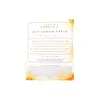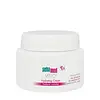What's inside
What's inside
 Key Ingredients
Key Ingredients

 Benefits
Benefits

 Concerns
Concerns

 Ingredients Side-by-side
Ingredients Side-by-side

Butyl Methoxydibenzoylmethane 3%
UV AbsorberEthylhexyl Methoxycinnamate 75%
UV AbsorberEthylhexyl Salicylate 4%
UV AbsorberBenzophenone-3 5%
UV AbsorberWater
Skin ConditioningSteareth-2
EmulsifyingHeptyl Undecylenate
EmollientEthylhexyl Triazone
UV AbsorberDimethicone
EmollientSteareth-21
CleansingOctyldodecanol
EmollientStearic Acid
CleansingC12-15 Alkyl Benzoate
AntimicrobialBis-Ethylhexyloxyphenol Methoxyphenyl Triazine
Skin ConditioningMethylene Bis-Benzotriazolyl Tetramethylbutylphenol
UV FilterPEG-30 Dipolyhydroxystearate
EmulsifyingRubus Chamaemorus Seed Extract
Skin ConditioningRubus Chamaemorus Seed Oil
Skin ConditioningButylene Glycol
HumectantPhenoxyethanol
PreservativeCetearyl Alcohol
EmollientTocopheryl Acetate
AntioxidantCaprylyl Glycol
EmollientPPG-15 Stearyl Ether
EmollientMica
Cosmetic ColorantCI 77891
Cosmetic ColorantCetearyl Dimethicone Crosspolymer
Panthenol
Skin ConditioningLecithin
EmollientDecyl Glucoside
CleansingAcrylates/C10-30 Alkyl Acrylate Crosspolymer
Emulsion StabilisingXanthan Gum
EmulsifyingMagnesium Ascorbyl Phosphate
AntioxidantSorbic Acid
PreservativePEG-8
HumectantDisodium EDTA
Sodium Hydroxide
BufferingTocopherol
AntioxidantSodium Lactate
BufferingLactic Acid
BufferingGlycerin
HumectantSerine
MaskingSorbitol
HumectantTea-Lactate
HumectantUrea
BufferingPropylene Glycol
HumectantAscorbyl Palmitate
AntioxidantSodium Chloride
MaskingChondrus Crispus
MaskingAscorbic Acid
AntioxidantCitric Acid
BufferingAllantoin
Skin ConditioningHippophae Rhamnoides Oil
EmollientRosmarinus Officinalis Leaf Extract
AntimicrobialHelianthus Annuus Seed Oil
EmollientCitral
PerfumingGeraniol
PerfumingHexyl Cinnamal
PerfumingLimonene
PerfumingLinalool
PerfumingButylphenyl Methylpropional
PerfumingParfum
MaskingButyl Methoxydibenzoylmethane 3%, Ethylhexyl Methoxycinnamate 75%, Ethylhexyl Salicylate 4%, Benzophenone-3 5%, Water, Steareth-2, Heptyl Undecylenate, Ethylhexyl Triazone, Dimethicone, Steareth-21, Octyldodecanol, Stearic Acid, C12-15 Alkyl Benzoate, Bis-Ethylhexyloxyphenol Methoxyphenyl Triazine, Methylene Bis-Benzotriazolyl Tetramethylbutylphenol, PEG-30 Dipolyhydroxystearate, Rubus Chamaemorus Seed Extract, Rubus Chamaemorus Seed Oil, Butylene Glycol, Phenoxyethanol, Cetearyl Alcohol, Tocopheryl Acetate, Caprylyl Glycol, PPG-15 Stearyl Ether, Mica, CI 77891, Cetearyl Dimethicone Crosspolymer, Panthenol, Lecithin, Decyl Glucoside, Acrylates/C10-30 Alkyl Acrylate Crosspolymer, Xanthan Gum, Magnesium Ascorbyl Phosphate, Sorbic Acid, PEG-8, Disodium EDTA, Sodium Hydroxide, Tocopherol, Sodium Lactate, Lactic Acid, Glycerin, Serine, Sorbitol, Tea-Lactate, Urea, Propylene Glycol, Ascorbyl Palmitate, Sodium Chloride, Chondrus Crispus, Ascorbic Acid, Citric Acid, Allantoin, Hippophae Rhamnoides Oil, Rosmarinus Officinalis Leaf Extract, Helianthus Annuus Seed Oil, Citral, Geraniol, Hexyl Cinnamal, Limonene, Linalool, Butylphenyl Methylpropional, Parfum
Water
Skin ConditioningPropylene Glycol Dicaprylate/Dicaprate
EmollientEthylhexyl Methoxycinnamate
UV AbsorberCetearyl Alcohol
EmollientPPG-2 Myristyl Ether Propionate
EmollientGlycerin
HumectantCetyl Palmitate
EmollientC12-15 Alkyl Benzoate
AntimicrobialPEG-20 Methyl Glucose Sesquistearate
EmulsifyingPanthenol
Skin ConditioningTocopheryl Acetate
AntioxidantSqualane
EmollientSodium Hyaluronate
HumectantAllantoin
Skin ConditioningCitric Acid
BufferingSodium Cetearyl Sulfate
CleansingMethyl Glucose Sesquistearate
EmollientSodium Carbomer
Emulsion StabilisingSodium Hydroxide
BufferingParfum
MaskingPhenoxyethanol
PreservativeSorbic Acid
PreservativeWater, Propylene Glycol Dicaprylate/Dicaprate, Ethylhexyl Methoxycinnamate, Cetearyl Alcohol, PPG-2 Myristyl Ether Propionate, Glycerin, Cetyl Palmitate, C12-15 Alkyl Benzoate, PEG-20 Methyl Glucose Sesquistearate, Panthenol, Tocopheryl Acetate, Squalane, Sodium Hyaluronate, Allantoin, Citric Acid, Sodium Cetearyl Sulfate, Methyl Glucose Sesquistearate, Sodium Carbomer, Sodium Hydroxide, Parfum, Phenoxyethanol, Sorbic Acid
Ingredients Explained
These ingredients are found in both products.
Ingredients higher up in an ingredient list are typically present in a larger amount.
Allantoin is a soothing ingredient known for its protective and moisturizingg properties. Because of this, it is often added to products with strong active ingredients.
Studies show higher concentrations of this ingredient can promote wound healing.
Though it can be derived from the comfrey plant, allantoin is produced synthetically for cosmetic products to ensure purity.
Learn more about AllantoinC12-15 Alkyl Benzoate is made up of Benzoic Acid and long chain alcohols. It has a low molecular weight.
C12-15 Alkyl Benzoate is an emollient and texture enhancer. Due to its solubility, it is often used in sunscreens to help evenly distribute active ingredients.
As an emollient, C12-15 Alkyl Benzoate helps soften and hydrate your skin. Emollients create a film on your skin that traps moisture within.
This ingredient has been reported to cause eye irritation.
Learn more about C12-15 Alkyl BenzoateCetearyl alcohol is a mixture of two fatty alcohols: cetyl alcohol and stearyl alcohol. It is mainly used as an emulsifier. Emulsifiers help prevent the separation of oils and products. Due to its composition, it can also be used to thicken a product or help create foam.
Cetearyl alcohol is an emollient. Emollients help soothe and hydrate the skin by trapping moisture.
Studies show Cetearyl alcohol is non-toxic and non-irritating. The FDA allows products labeled "alcohol-free" to have fatty alcohols.
This ingredient is usually derived from plant oils such as palm, vegetable, or coconut oils. There is debate on whether this ingredient will cause acne.
Due to the fatty acid base, this ingredient may not be Malassezia folliculitis safe.
Learn more about Cetearyl AlcoholCitric Acid is an alpha hydroxy acid (AHA) naturally found in citrus fruits like oranges, lemons, and limes.
Like other AHAs, citric acid can exfoliate skin by breaking down the bonds that hold dead skin cells together. This helps reveal smoother and brighter skin underneath.
However, this exfoliating effect only happens at high concentrations (20%) which can be hard to find in cosmetic products.
Due to this, citric acid is usually included in small amounts as a pH adjuster. This helps keep products slightly more acidic and compatible with skin's natural pH.
In skincare formulas, citric acid can:
While it can provide some skin benefits, research shows lactic acid and glycolic acid are generally more effective and less irritating exfoliants.
Most citric acid used in skincare today is made by fermenting sugars (usually from molasses). This synthetic version is identical to the natural citrus form but easier to stabilize and use in formulations.
Read more about some other popular AHA's here:
Learn more about Citric AcidEthylhexyl Methoxycinnamate is an organic compound that provides UVB protection. It often goes by the more common name of octinoxate. It is created from methoxycinnamic acid and 2-ethylhexanol.
Ethylhexyl Methoxycinnamate absorbs UVB rays with wavelengths between 280-320 nm. UV absorbers protect your skin by using chemical reactions to convert UV rays into heat and energy.
UVB (290-320 nm) rays emit more energy than UVA rays. They are capable of damaging DNA, causing sunburns and are thought to be linked to skin cancer.
The state of Hawaii has banned sunscreens containing octinoxate due to its potential impact on coral reefs. More research is needed to bridge gaps in this research. The European Union allows higher levels of octinoxate in sunscreens than the US and Australia.
Ethylhexyl Methoxycinnamate is oil soluble. It is not stable and may lose efficacy when exposed to sunlight.
Learn more about Ethylhexyl MethoxycinnamateGlycerin is already naturally found in your skin. It helps moisturize and protect your skin.
A study from 2016 found glycerin to be more effective as a humectant than AHAs and hyaluronic acid.
As a humectant, it helps the skin stay hydrated by pulling moisture to your skin. The low molecular weight of glycerin allows it to pull moisture into the deeper layers of your skin.
Hydrated skin improves your skin barrier; Your skin barrier helps protect against irritants and bacteria.
Glycerin has also been found to have antimicrobial and antiviral properties. Due to these properties, glycerin is often used in wound and burn treatments.
In cosmetics, glycerin is usually derived from plants such as soybean or palm. However, it can also be sourced from animals, such as tallow or animal fat.
This ingredient is organic, colorless, odorless, and non-toxic.
Glycerin is the name for this ingredient in American English. British English uses Glycerol/Glycerine.
Learn more about GlycerinPanthenol is a common ingredient that helps hydrate and soothe the skin. It is found naturally in our skin and hair.
There are two forms of panthenol: D and L.
D-panthenol is also known as dexpanthenol. Most cosmetics use dexpanthenol or a mixture of D and L-panthenol.
Panthenol is famous due to its ability to go deeper into the skin's layers. Using this ingredient has numerous pros (and no cons):
Like hyaluronic acid, panthenol is a humectant. Humectants are able to bind and hold large amounts of water to keep skin hydrated.
This ingredient works well for wound healing. It works by increasing tissue in the wound and helps close open wounds.
Once oxidized, panthenol converts to pantothenic acid. Panthothenic acid is found in all living cells.
This ingredient is also referred to as pro-vitamin B5.
Learn more about PanthenolParfum is a catch-all term for an ingredient or more that is used to give a scent to products.
Also called "fragrance", this ingredient can be a blend of hundreds of chemicals or plant oils. This means every product with "fragrance" or "parfum" in the ingredients list is a different mixture.
For instance, Habanolide is a proprietary trade name for a specific aroma chemical. When used as a fragrance ingredient in cosmetics, most aroma chemicals fall under the broad labeling category of “FRAGRANCE” or “PARFUM” according to EU and US regulations.
The term 'parfum' or 'fragrance' is not regulated in many countries. In many cases, it is up to the brand to define this term.
For instance, many brands choose to label themselves as "fragrance-free" because they are not using synthetic fragrances. However, their products may still contain ingredients such as essential oils that are considered a fragrance by INCI standards.
One example is Calendula flower extract. Calendula is an essential oil that still imparts a scent or 'fragrance'.
Depending on the blend, the ingredients in the mixture can cause allergies and sensitivities on the skin. Some ingredients that are known EU allergens include linalool and citronellol.
Parfum can also be used to mask or cover an unpleasant scent.
The bottom line is: not all fragrances/parfum/ingredients are created equally. If you are worried about fragrances, we recommend taking a closer look at an ingredient. And of course, we always recommend speaking with a professional.
Learn more about ParfumPhenoxyethanol is a preservative that has germicide, antimicrobial, and aromatic properties. Studies show that phenoxyethanol can prevent microbial growth. By itself, it has a scent that is similar to that of a rose.
It's often used in formulations along with Caprylyl Glycol to preserve the shelf life of products.
Sodium Hydroxide is also known as lye or caustic soda. It is used to adjust the pH of products; many ingredients require a specific pH to be effective.
In small amounts, sodium hydroxide is considered safe to use. However, large amounts may cause chemical burns due to its high alkaline.
Your skin has a natural pH and acid mantle. This acid mantle helps prevent harmful bacteria from breaking through. The acid mantle also helps keep your skin hydrated.
"Alkaline" refers to a high pH level. A low pH level would be considered acidic.
Learn more about Sodium HydroxideSorbic Acid is a preservative. It is the most commonly used food preservative in the world.
Sorbic Acid is a natural antibiotic and highly effective at preventing the growth of fungus. It is less effective against bacteria.
Potassium Sorbate, another commonly-used preservative, is the potassium salt of Sorbic Acid.
Sorbic Acid may worsen eczema. We recommend speaking with a professional if you have any concerns.
Potassium sorbate and sorbic acid can be found in baked goods, cheeses, dried meats, dried fruit, ice cream, pickles, wine, yogurt, and more.
Learn more about Sorbic AcidTocopheryl Acetate is AKA Vitamin E. It is an antioxidant and protects your skin from free radicals. Free radicals damage the skin by breaking down collagen.
One study found using Tocopheryl Acetate with Vitamin C decreased the number of sunburned cells.
Tocopheryl Acetate is commonly found in both skincare and dietary supplements.
Learn more about Tocopheryl AcetateWater. It's the most common cosmetic ingredient of all. You'll usually see it at the top of ingredient lists, meaning that it makes up the largest part of the product.
So why is it so popular? Water most often acts as a solvent - this means that it helps dissolve other ingredients into the formulation.
You'll also recognize water as that liquid we all need to stay alive. If you see this, drink a glass of water. Stay hydrated!
Learn more about Water